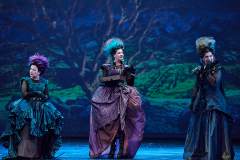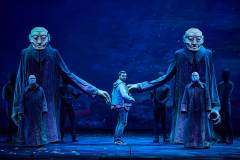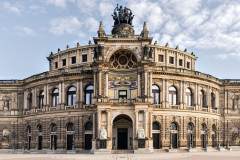The Magic Flute
Mo | Tu | We | Th | Fr | Sa | Su |
Die Zauberflöte / The Magic Flute - Wolfgang Amadeus Mozart
Opera in two acts
Libretto by Emanuel Schikaneder
Performed in German with German and English surtitles
Premiere: November 1, 2020
Mozart’s most popular opera is a deeply humane story of adventure with heavenly music.
Storyline
Act one
Prince Tamino is being pursued by a wild serpent. At the last minute, he is saved by three mysterious ladies who have been sent by the queen of the night. When the bird catcher Papageno appears and boasts about the heroic deed they punish him. In contrast, they give the prince a portrait of Pamina, the daughter of the queen who is being held captive by the ruler of the temple of the sun, Sarastro. Tamino falls in love with her. The queen appears in person and orders him to rescue Pamina together with Papageno. A magic flute will protect him from any danger whilst a reluctant Papageno is given magic bells. Guided by three young boys, they set off on their way to Sarastro’s temple. Whilst the temple guards tell Tamino that Sarastro is not the evil tyrant that the queen has depicted, Papageno finds Pamino and tries to flee with her. With the help of the chimes, he is able to distract her guard Monostatos although his efforts are scuppered by the appearance of Sarastro. Papageno, Pamina and Tamino have to stay in Sarastro’s kingdom as Sarastro has something greater planned for Tamino: just as he has taken Pamina into his kingdom to protect her from her mother, he plans to get Tamino into his circle of insiders of the sun temple and, in this way, prepare him for future tasks.
Act two
Tamino and Papageno are challenged to undergo various trials to prove that they are fit to be accepted into the circle of insiders. Firstly, they have to learn to remain silent which is difficult, particularly for Papageno. When an elderly woman appears, he is unable to keep this up and asks her what her name is. She then disappears with a clap of thunder. Papageno comforts himself with food and drink which is miraculously served to them both. Only Tamino remains silent and plays his flute for solace. Pamina appears but cannot understand why Tamino is no longer speaking to her. Her mother – the queen of the night – had previously tried in vain to persuade her to murder Sarastro. When, in her despair, she tries to take her life, the three young boys snatch the dagger away from her and lead her back to Tamino. Together they face the final test, the fire and water challenge. Protected by the magic sounds of the flute, they pass the test. Meanwhile, Papageno, in his loneliness, wishes that the elderly lady reappears and promises her that he will take her as his wife “as long as he doesn’t find anyone better”. She then transforms into a beautiful young girl but is taken away from him as the time has not yet come. Out of despair, Papageno wants to take his life but the three young boys remind him of the bells. The sound makes Papagena appear and both dream of a future with many children. The other couple is also happy: Tamino and Pamina, as future rulers, are accepted into the group of insiders and glorify the ideals of nature, wisdom and reason. Only the queen of the night comes to a bad ending: when she tries to enter the temple with her entourage, she is engulfed by the powers of darkness.
Program and cast
Sarastro: Georg Zeppenfeld (September 6, 13, 22, 2024, May 31, 2025), Tilmann Rönnebeck (October 4, November 17, 2024, January 5, 12, 19, May 31, June 2, 2025), Tobias Kehrer (November 15, 17, 28, 2024), Dimitry Ivashchenko (January 5, 19, 31, June 6, 2025)
Queen of the Night: Julia Sitkovetsky (September 6, 13, 22, November 28, 2024), Aigul Khismatullina (October 4, November 17, 2024, January 19, May 31, June 2, 2025), Jasmin Delfs (November 15, 17, 2024, January 12, 19, June 6, 2025), Maria Perlt-Gärtner (January 5, May 31, 2025)
Pamina: Victoria Randem (September 6, 13, 22, November 15, 17, 28, 2024, January 19, 31, May 31, June 2, 6, 2025), Heidi Stober (October 4, 2024, May 31, 2025), Nikola Hillebrand (January 5, 12, 19, 2025)
Tamino: James Ley (September 6, 13, November 15, 17, 28, 2024, January 5, 12, 19, 31, 2025), David Fischer (September 22, 2024, January 19, 2025), Tomislav Mužek (October 4, November 17, 2024), Magnus Dietrich (January 5, May 31, 2025), Mario Lerchenberger (May 31, June 2, 6, 2025)
Papageno: Michael Nagl (September 6, 13, October 4, November 28, 2024, January 5, 19, 2025), Sebastian Wartig (September 22, November 15, 17, 2024), Danylo Matviienko (November 17, 2024, January 5, 12, 19, 31, May 31, 2025), Joshua Hopkins (May 31, June 2, 6, 2025)
First Lady: Ann-Kathrin Niemczyk (September 6, October 4, 2024), Roxana Incontrera (September 13, November 15, 17, 2024, January 5, 19, May 31, June 2, 6, 2025), Ute Selbig (September 22, November 17, 28, 2024, January 5, 12, 19, 31, May 31, 2025)
Second Lady: Dominika Škrabalová (September 6, 13, October 4, November 15, 17, 2024), Sabine Brohm (September 22, November 17, 28, 2024, January 5, 19, May 31, 2025), Štěpánka Pučálková (January 5, 19, 31, 2025), Valerie Eickhoff (May 31, June 2, 6, 2025)
Third Lady: Michal Doron (September 6, 13, 22, October 4, January 19, May 31, 2025), Christa Mayer (November 15, 17, 28, 2024, January 5, 12, 19, 31, 2025), Nicole Chirka (May 31, June 2, 6, 2025)
Monostatos: Timothy Oliver (September 6, 13, October 4, November 15, 17, 28, 2024, January 19, May 31, June 6, 2025), Simeon Esper (September 22, 2024, January 5, May 31, June 2, 2025), Aaron Pegram (November 17, 2024, January 5, 12, 19, 31, 2025)
Speaker: Markus Marquardt (September 6, 13, 22, November 15, 17, 28, 2024, January 19, 31, 2025), Martin-Jan Nijhof (October 4, November 17, 2024, January 5, 2025), Alexandros Stavrakakis (January 12, 19, 2025), N.N. (May 31, June 2, 6, 2025)
Papagena: Sofia Savenko (September 6, 13, 22, October 4, November 17, 2024, January 5, 12, 19, 2025), Magdalena Lucjan (November 15, 17, 28, 2024, May 31, 2025), Christiane Hossfeld (January 5, May 31, June 2, 6, 2025)
First Priest: Anton Beliaev (September 6, 13, 22, November 28, 2024, January 12, 19, 31, May 31, June 2, 6, 2025), Gerrit Illenberger (October 4, November 15, 17, 2024, January 5, 2025)
Second Priest: Aaron Pegram (September 6, 13, 22, 2024, May 31, June 2, 6, 2025), Jongwoo Hong (October 4, November 15, 17, 28, 2024, January 5, 12, 19, 31, 2025)
First Armored Man: Jürgen Müller (September 6, 13, 22, October 4, November 15, 17, 28, 2024, January 5, 19, 31, May 31, 2025), Gerald Hupach (November 17, 2024, January 12, 19, May 31, June 2, 6, 2025)
Second Armored Man: Matthias Henneberg (September 6, 13, 22, October 4, November 15, 17, 28, 2024), Oleksandr Pushniak (January 5, 12, 19, 31, May 31, June 2, 6, 2025)
Three Boys: Dresdner Kreuzchor (September 6, 13, 22, October 4, November 28, 2024, January 31, 2025), Aurelius Sängerknaben Calw (November 15, 17, 2024, January 12, June 2, 6, 2025), Tölzer Knabenchor (January 5, 19, May 31, 2025)
Musical Direction: Giulio Cilona (September 6, 13, 22, October 4, November 15, 17, 2024), Katharina Müllner (November 28, 2024, January 5, 12, 19, 31, 2025), Gaetano d’Espinosa (May 31, June 2, 6, 2025)
Staging: Josef E. Köpplinger
Set Design: Walter Vogelweider
Costumes: Dagmar Morell
Choreography: Ricarda Regina Ludigkeit (September 6, 13, 22, October 4, November 15, 17, 28, 2024, January 5, 12, 19, 31, May 31, June 2, 6, 2025), Walter Vogelweider (May 31, 2025)
Lighting: Fabio Antoci
Chorus: Jan Hoffmann
Dramaturgy: Johann Casimir Eule
Sächsische Staatskapelle Dresden
Sächsischer Staatsopernchor Dresden
Work Introduction (free)
45 minutes before the performance in the opera cellar
Semperoper Dresden
The Semperoper is the opera house of the Sächsische Staatsoper Dresden (Saxon State Opera) and the concert hall of the Sächsische Staatskapelle Dresden (Saxon State Orchestra). It is also home to the Semperoper ballet. The building is located near the Elbe River in the historic centre of Dresden, Germany.
The opera house was originally built by the architect Gottfried Semper in 1841. After a devastating fire in 1869, the opera house was rebuilt, partly again by Semper, and completed in 1878. The opera house has a long history of premieres, including major works by Richard Wagner and Richard Strauss.
The first opera house at the location of today's Semperoper was built by the architect Gottfried Semper. It opened on 13 April 1841 with an opera by Carl Maria von Weber. The building style itself is debated among many, as it has features that appear in three styles; Early Renaissance and Baroque, with Corinthian style pillars typical of Greek classical revival. Perhaps the most suitable label for this style would be eclecticism, where influences from many styles are used, a practice most common during this period. Nevertheless, the opera building, Semper's first, is regarded as one of the most beautiful European opera houses.

 EN
EN DE
DE IT
IT FR
FR ES
ES RU
RU JP
JP RO
RO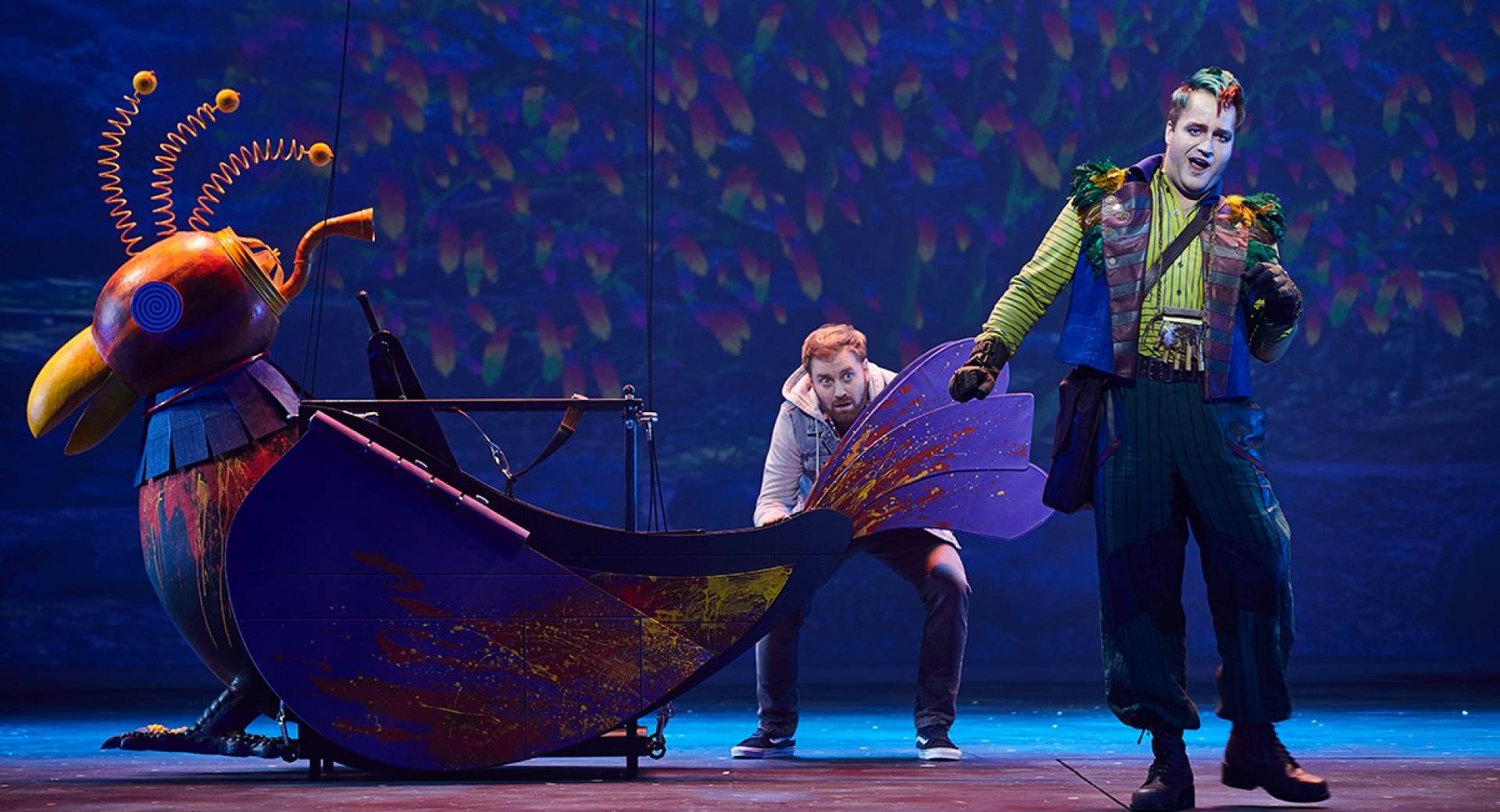
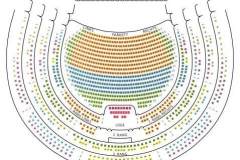 Seating plan
Seating plan 
